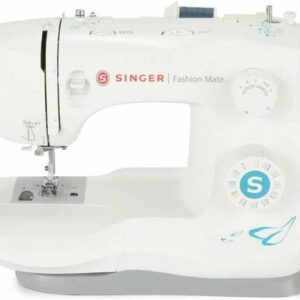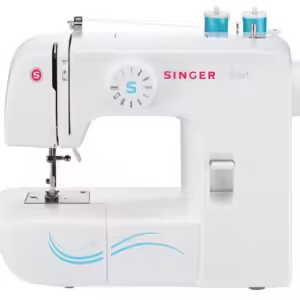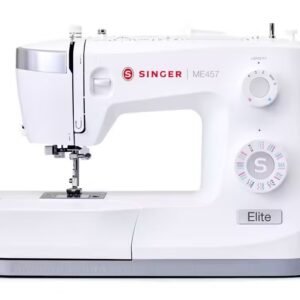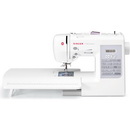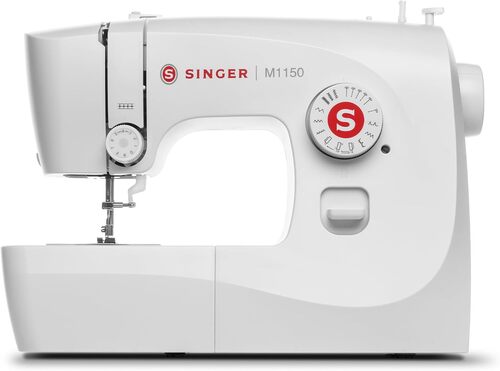
I’m the sort of crafter who lives on Pinterest optimism and coffee — so when my thirty-year-old metal Singer finally wheezed its last, I plunged into a sea of Singer M1150 reviews to find a replacement. Over and over I saw the same refrain: light, simple, budget-friendly, sometimes fussy — but perfect for learning or light projects. That sounded exactly like me. So, here’s my very personal Singer M1150 review, straight from the first stitch to a year of real-world use.
Unboxing & first impressions
The box landed on my porch two days after I clicked “Buy.” I lifted the machine with one hand — a shock after hefting my vintage tank—and noticed two things immediately:
- Mostly plastic, but not flimsy. The shell feels tough enough to toss into a closet without babying it.
- No printed manual. Just a postcard telling me to download the PDF. Cue frantic Googling and a quick side trip to YouTube.
Despite the paperless start, the Singer M1150 came pre-threaded, bobbin loaded, and ready to test. That little courtesy let me trace the thread path before I ever touched the hand-wheel.
The first battle: threading & tension
If you have nimble fingers and young eyes, the upper threading takes maybe a minute. My forty-something eyes? Ten. The built-in light is gentle on glare but not bright enough to spotlight the needle eye, so I dragged a desk lamp over.
My real hurdle was tension. On denim scraps the upper stitches looked great, but flip the fabric and—bird’s-nest city. Remembering a tip from multiple Singer M1150 reviews, I popped the metal bobbin case out, gave the tiny minus-shaped screw a quarter turn, and voilà: clean stitches top and bottom. Lesson learned—this machine likes a little tweak before it sings.
First projects: victories & hiccups
Project 1: Jedi robe (fleece)
- The feed dogs chugged through two layers of thick fleece without a skipped stitch.
- Speed is modest; I could floor the foot pedal and still feel in control.
Project 2: Buttonholes on cotton poplin
- The four-step buttonhole works, but you must keep tension on the loose side (around 2.5–3).
- I marked the positions with tailor’s chalk, took it slow, and they turned out crisp. A neighbor’s eight-year-old even did one after I set it up.
Project 3: Hemming jeans
- Two folded seams was the machine’s limit. Any thicker and the needle deflected. Swapping to a size 16 denim needle helped, but this isn’t a heavy-duty beast.
Everyday life with the M1150
- Portability: It rides in my camper every summer, weighs about as much as a stand mixer, and stores under the dinette.
- Noise: Softer than my coffee grinder—perfect for late-night mending while the kids sleep.
- Maintenance: A monthly dust-out and a drop of oil keep it humming. The plastic hand-wheel still feels solid after a year.
- Learning curve: My seven-year-old niece pieced a doll pillow after a single afternoon. My 76-year-old neighbor struggled with the needle-threading space but managed with a pair of tweezers.
Quirks that still bug me
| Minor Gripe | Why it matters |
|---|---|
| Dim sewing light | Extra lamp needed for dark fabrics |
| Short, stiff foot-pedal cord | Pedal skates sideways unless I park a rubber mat under it |
| Manual only online | Beginners without internet feel stranded |
| Plastic presser-foot lever | Works fine but feels like it could snap if I get rough |
None of these are dealbreakers, but they show where Singer shaved costs.
Final thoughts—and who should buy it
If you crave an all-metal, heirloom-grade machine, keep looking. But if you want a friendly starter or a travel sidekick that tackles everyday hems, Halloween costumes, and pillow covers without drama, the Singer M1150 is a winner. It turned this coffee-fueled dreamer into someone who actually finishes projects — and that alone makes it priceless.
So that’s my story. One year, three dozen repairs, and countless late-night creative bursts later, I’m still glad I listened to those Singer M1150 reviews and hit “Buy Now.”
Pros and Cons of the SINGER M1150 based on other Customer Reviews
| Pros | Cons |
|---|---|
| True beginner-friendly setup – many first-timers in these Singer M1150 reviews say the machine arrives pre-threaded, YouTube guides are abundant, and they were sewing in under an hour. | Plastic build & parts – several owners call the machine “mostly plastic,” noting fragile bobbin housings, presser-foot levers, and worries about long-term durability. |
| Lightweight & portable – at about 12 lb, the M1150 tucks into closets, camper cupboards, or even luggage for classes and travel. | Dim workspace light – multiple users complain the LED doesn’t illuminate the needle area; most add a desk lamp. |
| Budget price, good value – repeatedly labelled a “great little starter” under $100, making DIY hemming cheaper than a tailor. | Threading & bobbin can be fussy – tight needle area challenges older hands; wrong bobbin tension or mis-threading causes bird-nest tangles until adjusted. |
| Decent stitch quality for basics – straight, zig-zag, blind-hem and 4-step buttonhole stitches finish evenly on cotton, fleece and medium denim when tension is set correctly. | Limited power on heavy fabrics – struggles over thick seams, upholstery, or multi-layer denim; heavy-duty needles help but don’t fully fix it. |
| Quiet, smooth motor – users like the low noise and steady feed for late-night crafting. | Sparse/online-only manual – paper instructions are pictograms; full guide requires a download, frustrating users without easy internet access. |
| Kid-friendly – parents & grandparents report 7- and 8-year-olds successfully making doll clothes and pillows under supervision. | Short, slippery foot-pedal cord – stiff cable enters the side of the pedal, so it twists or slides without a rubber mat. |
| Versatile enough for quick repairs – hems, masks, button re-attachments and even outdoor-fabric cushions completed with no skipped stitches. | Speed & power feel “half strength” – a few experienced sewists say the pedal tops out slower than older, metal Singers, making long seams tedious. |
| Free-arm & onboard storage – removable accessory tray lets users slip pant legs around the arm and stash feet/bobbins inside. | Quality-control hiccups – scattered reports of machines arriving pre-used, missing manuals, or failing within a year and being hard to service under warranty. |
SINGER M1150 Sewing Machine – Frequently Asked Questions
Is the Singer M1150 really beginner-friendly?
Yes. Across dozens of Singer M1150 reviews , absolute beginners—even kids—report getting their first seam done in under an hour once the machine is correctly threaded. It ships pre-threaded, has only six core stitches and a simple dial, so there’s little to overwhelm you.
What stitches does the Singer M1150 have?
According to the official Singer M1150 manual, you get two straight-stitch positions, a basic zig-zag, a satin zig-zag, a multi-step zig-zag, blind-hem options for wovens and knits, plus a four-step buttonhole—plenty for everyday mending and craft work.
Can it handle denim or thick fabric?
The consensus from Singer M1150 review threads is: light hems on denim are fine with a size-16 needle, but the lightweight motor will struggle on multi-layer jeans or upholstery. For heavy-duty work, owners suggest stepping up to a stronger model.
How hard is threading the Singer M1150?
Once you raise the presser foot and follow the numbered path, threading is straightforward. Most jams in Singer M1150 reviews happen when the presser foot is left down or the take-up lever is missed, so lift the foot, follow the slots and you’ll be good.
Does it come with a printed manual?
No—Singer ships only a quick-start card. The full PDF manual must be downloaded, which many users in their Singer M1150 review call inconvenient if you’re offline. Tip: print the key pages or keep them on your phone for reference.
How portable is the Singer M1150?
At roughly 6 kg (about 12 lb) with a built-in handle, it’s light enough for classes, campers, or quick closet storage. Portability is one of the most-praised pros in Singer M1150 reviews .
Which bobbins and needles should I buy?
Stick with transparent Class 15 bobbins and standard 130/705H needles. Owners recommend sizes 70–90 for quilting cotton and 100/110 for thicker fabrics.
How do I sew buttonholes on this machine?
Select the four-step buttonhole setting, mark your button length plus 3 mm, and follow the A-B-C-D sequence on the dial. Many Singer M1150 review writers suggest practicing on scrap first to balance the columns evenly.
Why is my thread looping or jamming?
Nine times out of ten the upper thread isn’t fully seated in the tension discs. Rethread with the presser foot UP, make sure the take-up lever is threaded, then test again. This quick fix appears in countless Singer M1150 reviews .
What routine maintenance does it need?
Brush lint from the feed dogs and bobbin area after each project, snip stray threads, and keep a cover on it. The LED bulb means no oiling is required—just the occasional cleanup recommended in the Singer M1150 manual.
| Specification | Details |
|---|---|
| Maximum Sewing Speed | 550 ± 50 stitches per minute (straight stitch, default length) |
| Rated Voltage | 100 V – 240 V, 50/60 Hz (models for various regions) |
| Presser Foot Lift | 6.5 mm |
| Protection Class | Class II (double insulated) |
| Stitch Width | 0 – 5.0 mm |
| Stitch Length | 0 – 4.0 mm |
| Light Type | LED |
| Machine Dimensions (L × W × H) | 425 mm × 174 mm × 320 mm |
| Weight | 6 kg |

